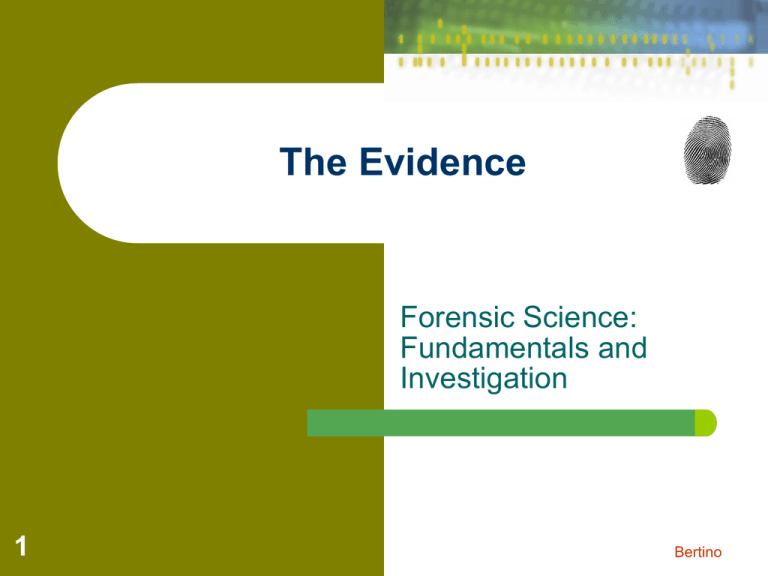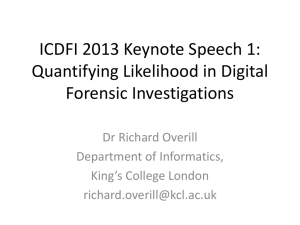The Evidence Forensic Science: Fundamentals and Investigation
advertisement

The Evidence Forensic Science: Fundamentals and Investigation 1 Bertino Packaging the evidence Crease a clean paper and place evidence in the X position 2. Fold in the left and right sides, and then fold in the top and bottom 3. Put the bindle into a plastic or paper evidence bag affixing a seal over the opening 4. Write your name on the seal 1. 2 Forensic Science: Fundamentals & Investigations, Chapter 2 Avoiding Contamination o 3 Contamination is a key concern during the collection of DNA-containing specimens such as blood, saliva, sweat or skin cells. Contamination can occur either by introducing foreign DNA through coughing or sneezing onto evidence or if items of evidence are incorrectly placed in contact with each other during packaging. Forensic Science: Fundamentals & Investigations, Chapter 2 Evidence ID Forms 4 Forensic Science: Fundamentals & Investigations, Chapter 2 Chain of Custody Maintaining a chain of custody log is essential to present credible evidence in court 5 Forensic Science: Fundamentals & Investigations, Chapter 2 Chain of Custody (cont’d.) 1. Bag the evidence Add identification Seal it Sign it across the sealed edge 2. Sign over to a lab technician Open bag on non-sealed edge 3. Return items to the evidence bag Seal evidence bag in another bag Sign the evidence log 6 Forensic Science: Fundamentals & Investigations, Chapter 2 Reference Samples o Standard/Reference Sample • 7 Physical evidence whose origin is known, such as blood or hair from a suspect, that can be compared to crime-scene evidence. Forensic Science: Fundamentals & Investigations, Chapter 2 Leaving the Scene o o 8 The experienced lead investigator decides when all pertinent physical evidence has been recorded and collected at the crime scene. A final survey is undertaken to visually review the scene and collect all evidence and equipment Forensic Science: Fundamentals & Investigations, Chapter 2 Submitting the Evidence o 9 Most laboratories require that an evidence submission form accompany all evidence submitted. Case information provided on this form enables the laboratory analyst to make an intelligent and complete examination of the evidence. Forensic Science: Fundamentals & Investigations, Chapter 2 Analyze the Evidence o o 10 Facts result from collected evidence processed by the forensic lab Lead detective aims to see how facts fit into the crime scenario Forensic Science: Fundamentals & Investigations, Chapter 2 Analyze the Evidence Lab results can: o Show reliability of witness accounts o Establish the identity of suspects or victims o Show suspects to be innocent or link them with a scene or victim 11 Forensic Science: Fundamentals & Investigations, Chapter 2 Safety at the Crime Scene o 12 Crime scenes frequently present the investigator with biological specimens of unknown origin; the investigator has no way of gauging what health hazards they may contain. One must use caution and protection at all times. Forensic Science: Fundamentals & Investigations, Chapter 2 Search and Seizure o 13 The removal of any evidence from a person or from the scene of a crime must be done in conformity with Fourth Amendment privileges: Forensic Science: Fundamentals & Investigations, Chapter 2 SCOTUS Says…. o Search and seizure without a courtapproved warrant is justified in four cases: 1. 2. 14 The existence of emergency circumstances The need to prevent the immediate loss or destruction of evidence Forensic Science: Fundamentals & Investigations, Chapter 2 3. 4. 15 A search of a person and property within the immediate control of the person provided it is made incident to a lawful arrest A search made by consent of the parties involved Forensic Science: Fundamentals & Investigations, Chapter 2 Search and Seizure Cases o 16 In the case of Mincey v. Arizona, the Court dealt with the legality of a fourday search at a homicide scene and determined that the evidence was illegally seized because a warrant was never issued and the circumstances of the case did not justify a warrantless search. Forensic Science: Fundamentals & Investigations, Chapter 2 More Cases… o 17 In Michigan v. Tyler, fire destroyed a business establishment leased by Loren Tyler and a business partner. The court decided that evidence obtained from the initial search was legally seized, but evidence obtained from searches 4, 7, and 24 days after the incident were illegally seized. Forensic Science: Fundamentals & Investigations, Chapter 2


